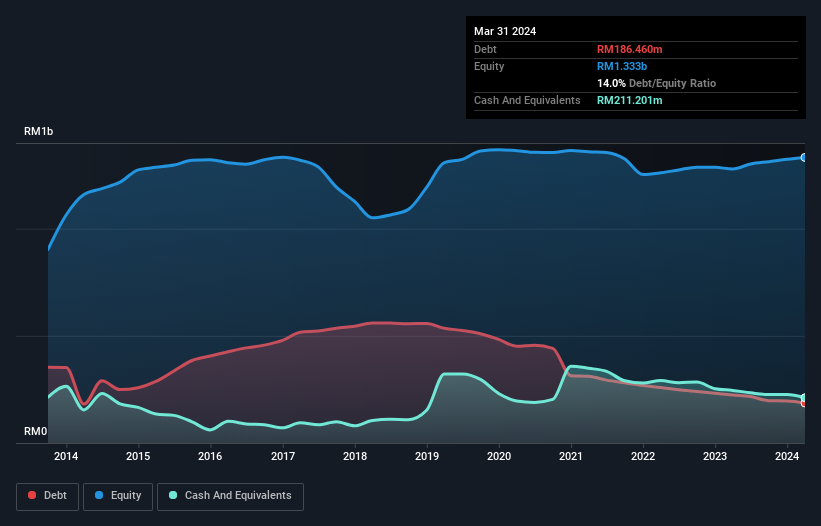Warren Buffett famously said, 'Volatility is far from synonymous with risk.' So it seems the smart money knows that debt - which is usually involved in bankruptcies - is a very important factor, when you assess how risky a company is. We can see that Naim Holdings Berhad (KLSE:NAIM) does use debt in its business. But should shareholders be worried about its use of debt?
What Risk Does Debt Bring?
Debt assists a business until the business has trouble paying it off, either with new capital or with free cash flow. In the worst case scenario, a company can go bankrupt if it cannot pay its creditors. While that is not too common, we often do see indebted companies permanently diluting shareholders because lenders force them to raise capital at a distressed price. Of course, debt can be an important tool in businesses, particularly capital heavy businesses. The first thing to do when considering how much debt a business uses is to look at its cash and debt together.
Check out our latest analysis for Naim Holdings Berhad
What Is Naim Holdings Berhad's Debt?
As you can see below, Naim Holdings Berhad had RM186.5m of debt at March 2024, down from RM224.1m a year prior. However, its balance sheet shows it holds RM211.2m in cash, so it actually has RM24.7m net cash.

How Healthy Is Naim Holdings Berhad's Balance Sheet?
The latest balance sheet data shows that Naim Holdings Berhad had liabilities of RM381.1m due within a year, and liabilities of RM82.0m falling due after that. Offsetting these obligations, it had cash of RM211.2m as well as receivables valued at RM149.8m due within 12 months. So it has liabilities totalling RM102.1m more than its cash and near-term receivables, combined.
Of course, Naim Holdings Berhad has a market capitalization of RM656.0m, so these liabilities are probably manageable. But there are sufficient liabilities that we would certainly recommend shareholders continue to monitor the balance sheet, going forward. While it does have liabilities worth noting, Naim Holdings Berhad also has more cash than debt, so we're pretty confident it can manage its debt safely. The balance sheet is clearly the area to focus on when you are analysing debt. But it is Naim Holdings Berhad's earnings that will influence how the balance sheet holds up in the future. So if you're keen to discover more about its earnings, it might be worth checking out this graph of its long term earnings trend.
Over 12 months, Naim Holdings Berhad made a loss at the EBIT level, and saw its revenue drop to RM329m, which is a fall of 2.5%. That's not what we would hope to see.
So How Risky Is Naim Holdings Berhad?
While Naim Holdings Berhad lost money on an earnings before interest and tax (EBIT) level, it actually booked a paper profit of RM46m. So when you consider it has net cash, along with the statutory profit, the stock probably isn't as risky as it might seem, at least in the short term. Until we see some positive EBIT, we're a bit cautious of the stock, not least because of the rather modest revenue growth. There's no doubt that we learn most about debt from the balance sheet. However, not all investment risk resides within the balance sheet - far from it. To that end, you should learn about the 2 warning signs we've spotted with Naim Holdings Berhad (including 1 which makes us a bit uncomfortable) .
If you're interested in investing in businesses that can grow profits without the burden of debt, then check out this free list of growing businesses that have net cash on the balance sheet.
Valuation is complex, but we're here to simplify it.
Discover if Naim Holdings Berhad might be undervalued or overvalued with our detailed analysis, featuring fair value estimates, potential risks, dividends, insider trades, and its financial condition.
Access Free AnalysisHave feedback on this article? Concerned about the content? Get in touch with us directly. Alternatively, email editorial-team (at) simplywallst.com.
This article by Simply Wall St is general in nature. We provide commentary based on historical data and analyst forecasts only using an unbiased methodology and our articles are not intended to be financial advice. It does not constitute a recommendation to buy or sell any stock, and does not take account of your objectives, or your financial situation. We aim to bring you long-term focused analysis driven by fundamental data. Note that our analysis may not factor in the latest price-sensitive company announcements or qualitative material. Simply Wall St has no position in any stocks mentioned.
Have feedback on this article? Concerned about the content? Get in touch with us directly. Alternatively, email editorial-team@simplywallst.com
About KLSE:NAIM
Naim Holdings Berhad
An investment holding company, engages in the property development and construction businesses in Malaysia.
Flawless balance sheet with solid track record.
Market Insights
Community Narratives



